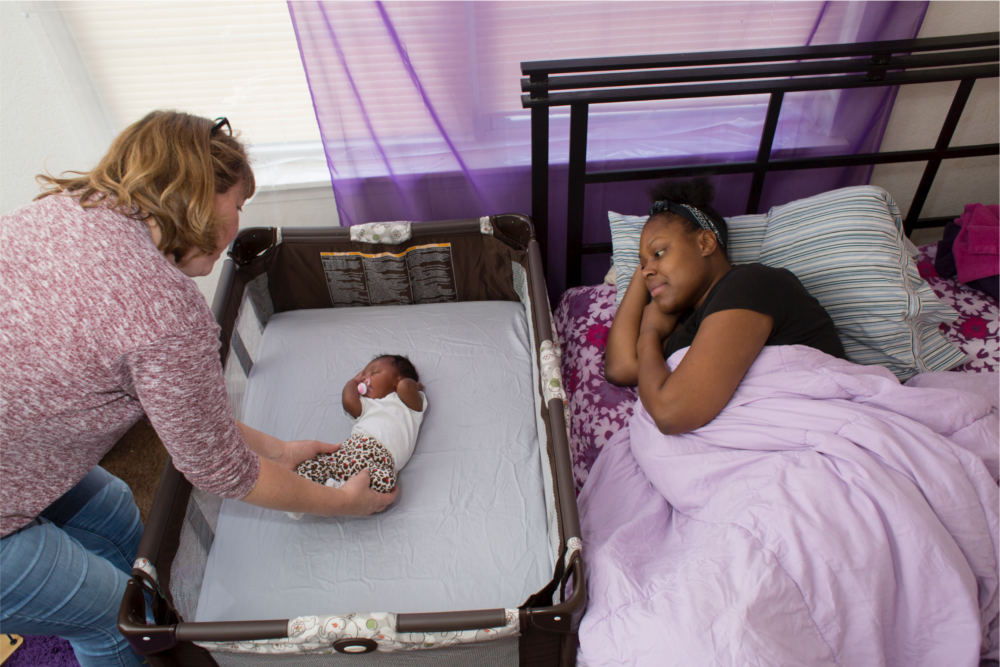

Public Sector Solutions, Children & Families, Results-Based Funding
Key Takeaway
The reauthorization of MIECHV signals a federal commitment to improving outcomes for families. We look forward to supporting communities in responding to these new provisions to more effectively deliver home visiting across the country.
$400M
Added investment in home visiting over five years
For more than a decade, Social Finance has worked with government and nonprofit partners to design and implement data-driven programs that support families in the transition to parenthood. Congress’ recent reauthorization of the Maternal, Infant, and Early Childhood Home Visiting (MIECHV) Program will help to expand such projects by doubling funding for services for pregnant individuals and families of children ages 0-5 over the next five years. Three new provisions of The Jackie Walorski Maternal and Child Home Visiting Reauthorization Act of 2022 (brief here) indicate that MIECHV aims to prioritize and adapt home visiting services through an increase in total funding, a 2x investment increase in tribal communities, and improved guidelines on virtual service delivery. In addition, new requirements for an outcomes dashboard and an annual report to Congress offer opportunities to improve learning among state leaders and share best practices among home visiting programs.
What is MIECHV?
Created through the Affordable Care Act and administered by the Health Resources and Services Administration (HRSA) and the Administration for Children & Families (ACF), MIECHV provides funding to states, territories, and tribal communities for home visiting: voluntary supports for pregnant individuals and families with young children to strengthen parenting practices, foster child development, and improve health outcomes.
MIECHV is an example of evidence-based policymaking (and includes specific language on “pay for outcomes” initiatives). States complete a rigorous assessment to identify high-need communities within their states. Home visiting programs then focus on serving families from those communities and other priority populations, such as families who identify as low-income, have histories of substance use, or have children with developmental delays. States must direct at least 75% of their MIECHV funding to home visiting programs that offer evidence-based models, typically delivered through community-based organizations, hospitals, and other centers. Home visiting programs deliver services and report on 19 performance measures related to maternal and child health, school readiness, and economic security.
73,000
Families benefited from home visiting funded by MIECHV in 2021
What is significant about the reauthorization?
First, the reauthorization doubles the total investment in home visiting from $400 million to $800 million in five years. Base federal funding increases from $400 million to $500 million starting in October 2022 and a new match requirement grows to $300 million by October 2026. In 2021, MIECHV funded home visiting for over 73,000 families nationally, but with this funding increase, many more families could be served each year.
Second, the reauthorization doubles the funding set aside for tribal communities from 3% to 6%. The history of tribal communities in the U.S. is marked with genocide, forced assimilation, and coerced sterilization, leading to generational trauma and persistent inequities across economic and health factors. In 2021, 24% of Indigenous Americans lived in poverty compared to 12% of the general U.S. population, and Indigenous American women are twice as likely to die from a pregnancy-related cause than their white peers. Access to home visiting can provide families with crucial supports.
Third, the bill embraces virtual home visiting as a valid service delivery format. Covid-19 forced home visitors to transition to virtual visits. Under the reauthorization, virtual home visiting will continue to be allowed as long as it is an enhancement or evidence-based adaptation to the model, in order to maintain rigorous evidence standards. Virtual home visiting will likely enable programs to reach new families, such as those living in rural communities or those who frequently move. However, virtual home visiting may make it more challenging to assess for certain risk factors, such as intimate partner violence.
2x
Investment increase in tribal communities
How can communities learn from MIECHV’s outcomes reporting?
Social Finance’s work with home visiting systems in Connecticut (including a new program in the state), Delaware, Missouri, South Carolina, and Texas seeks to expand services and measurably improve family outcomes. It is with this orientation that we are interested in the reauthorization’s two new tools to summarize performance.
The first tool is a publicly available outcomes dashboard. The second is an annual report to Congress, which would include each state’s outcomes, demographics, scale, description of home visiting models, and description of the funding leveraged. Based on our experience supporting home visiting systems, federal, state, and local stakeholders could maximize learning by incorporating the following considerations:
- Incorporate demographic filters: In addition to reporting on program demographics, the dashboard should embed filters for race, ethnicity, educational attainment, and household income, for instance. Understanding differences by subgroup could indicate whether programs are equitably enrolling and serving diverse families.
- Include underlying detail for each performance measure: Visualizing nuances within each performance measure’s definition could help states to understand service delivery and inform operational recommendations. As an example, MIECHV’s depression screening measure is defined as the “percent of primary caregivers enrolled in home visiting who are screened for depression using a validated tool within 3 months of enrollment (for those not enrolled prenatally) or within 3 months of delivery (for those enrolled prenatally).” The dashboard could visualize whether there are differences in depression rates based on when the caregiver was screened and whether the caregiver enrolled before or after the child’s birth.
- Focus on home visiting providers: The success of MIECHV ultimately relies on home visiting providers. The data dashboards could integrate pertinent information about providers, including provider type and home visiting model, to observe any differences in the performance measures by these characteristics. For example, do hospital-based programs have higher prenatal enrollment rates? In tandem, the annual report to Congress should emphasize the expertise of home visitors. This could be achieved through focus groups or surveys distributed to home visitors in MIECHV-funded programs, intending to capture a holistic view of the successes and challenges of delivering home visiting throughout the country.
- Elevate families’ stories: As the subcommittee hearing for the reauthorization demonstrated, the impact of home visiting goes beyond the numbers—real families’ lives are touched by having a trusting relationship with someone invested in them and their children. Developing a process for the annual report to uplift family testimonials could communicate the impact of home visiting to policymakers. Additionally, states that have led successful efforts to highlight the stories of families in home visiting could offer suggestions to other states, and HRSA and ACF could compile and promote the result of these efforts.
The reauthorization of MIECHV signals a federal commitment to improving outcomes for families. We look forward to supporting communities in responding to these new provisions to more effectively deliver home visiting across the country.
Learn more about our Public Sector Solutions →
Related Insight

Designing an Outcomes Rate Card Approach in Connecticut to Better Serve Families
Social Finance and OEC conducted an extensive review of their rate card implementation and determined that the model would be more impactful and easier to implement if it were more clearly aligned with OEC’s goals…

Incorporating Payment Incentives for Early Childhood Outcomes in Maternal, Infant, and Early Childhood Home Visiting Contracts in Connecticut
Social Finance partnered with the Connecticut Office of Early Childhood (OEC) to pilot home-visiting initiative designed to improve early childhood mental health outcomes and respond to adverse childhood experiences.

3 Lessons to Effectively Leverage Outcomes-Based Funding to Improve Home Visiting Services in Missouri
CTF worked with Social Finance to design an outcomes rate card (ORC), an OBF structure that includes a menu of high-priority outcome metrics CTF hopes to achieve and an associated payment, or “price,” for each…